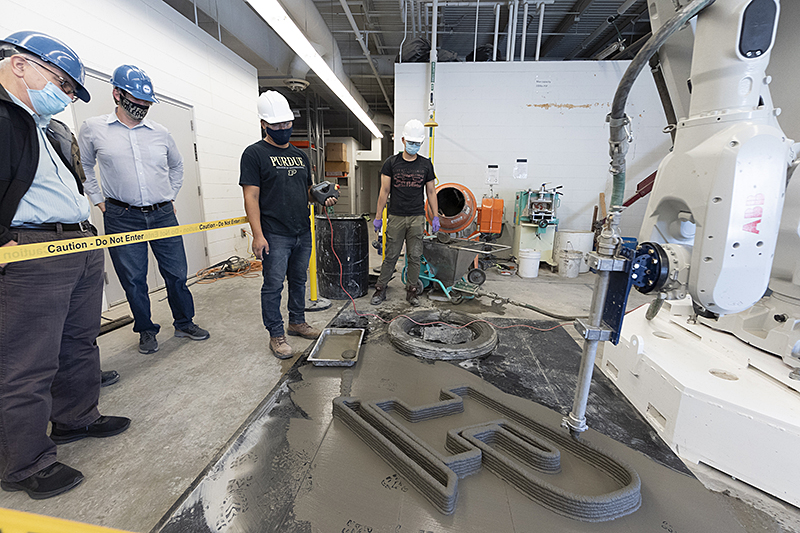November 15, 2021
Purdue researchers test 3D concrete printing system as part of NSF-funded project

Purdue University Ph.D. student Fabian B. Rodriguez (second from right) explains the 3D printing process to faculty advisors Jan Olek (left) and Jeffrey P. Youngblood (second from left) in Purdue University’s Robert L. and Terry L. Bowen Laboratory. They are conducting research into RCAM Technologies' 3D-printed suction anchors to replace traditional anchors for offshore wind plants. (Purdue University photo/Vincent Walter)
WEST LAFAYETTE, Ind. – Transitioning to clean wind energy could become more cost-efficient as Purdue University researchers test a new technology created by an international startup to anchor offshore wind turbines.
RCAM Technologies, which has offices in the U.S. and U.K., received a Phase I Small Business Technology Transfer grant from the National Science Foundation to develop concrete, 3D-printed suction anchors to replace traditional anchors for offshore wind plants. Research will be conducted at the Robert L. and Terry L. Bowen Laboratory for Large-Scale Civil Engineering Research in Purdue's College of Engineering.
Gabriel Falzone, director of operations at RCAM Technologies, said traditional anchors for floating offshore wind plants are made from steel. This makes them expensive and carbon-intensive; they also require large vessels for installation.
 Purdue University engineers (from left) Jan Olek, Jeffrey P. Youngblood and Pablo Zavattieri conduct research with Ph.D. student Fabian B. Rodriguez (far right) on concrete 3D printing technology from RCAM Technologies. (Purdue University photo/Vincent Walter)
Download image
Purdue University engineers (from left) Jan Olek, Jeffrey P. Youngblood and Pablo Zavattieri conduct research with Ph.D. student Fabian B. Rodriguez (far right) on concrete 3D printing technology from RCAM Technologies. (Purdue University photo/Vincent Walter)
Download image
"Our concrete, 3D-printed suction anchors will reduce the cost of anchors by up to 90% compared with traditional drag anchors when used in a shared mooring configuration," Falzone said. "Suction anchors can accept loading in multiple directions, which allows them to be connected to multiple turbines. This can reduce the number of anchors required per plant."
Research on the anchors will be led by Jan Olek, the James H. and Carol H. Cure Professor in Civil Engineering, Pablo D. Zavattieri, the Jerry M. and Lynda T. Engelhardt Professor in Civil Engineering, both from the Lyles School of Civil Engineering, and Jeffrey P. Youngblood, professor in the School of Materials Engineering.
"Working with Purdue has accelerated commercialization and provided us with access to critical expertise and facilities," Falzone said. "Purdue's expertise in concrete durability and structural testing is some of the best in the world."
Fabian Rodriguez, a graduate student in the Lyles School of Civil Engineering working on the project, said the research focuses on developing the 3D-printing process at larger scales.
"Being able to understand the behavior of cementitious materials in different 3D-printing systems allows us to have a clear idea of the physical characteristics and quality of the materials that we want to use for large-scale construction in marine environments," Rodriguez said. "The current robotic system will allow us to produce larger elements on which we can evaluate properties such as their strength and durability."
Olek said a challenging aspect of this application of 3D-printed concrete is that it will be exposed to a marine environment.
"That means exposure to elevated levels of chlorides that can chemically react with the hydrated cementitious matrix and potentially negatively impact the durability of the anchor," Olek said. "We are looking into the microstructure of concrete created during the layer-by-layer deposition process. We want to know how it influences the permeability and rate of ingress of chlorides into the printed element and to assess impact on durability."
Youngblood said, "3D printing can be overhyped, as in many instances it is a more expensive way to make something worse. 3D printing shines where labor costs are high and structures are unique and/or complex. Here, it has the chance to really make an impact, as construction is labor-intensive, and this particular design would be difficult with other manufacturing methods."
Zavattieri said the research is a great example of academia-industry collaboration.
"We share know-how and equipment, and yet we work together toward developing a new technology that has the potential to enable novel and more efficient ways to build structures," Zavattieri said. "This collaboration allows us to build these unique capabilities here at Purdue."
About Purdue University
Purdue University is a top public research institution developing practical solutions to today’s toughest challenges. Ranked in each of the last four years as one of the 10 Most Innovative universities in the United States by U.S. News & World Report, Purdue delivers world-changing research and out-of-this-world discovery. Committed to hands-on and online, real-world learning, Purdue offers a transformative education to all. Committed to affordability and accessibility, Purdue has frozen tuition and most fees at 2012-13 levels, enabling more students than ever to graduate debt-free. See how Purdue never stops in the persistent pursuit of the next giant leap at https://purdue.edu/.
Writer: Steve Martin, sgmartin@prf.org
Sources: Gabriel Falzone, gabriel.falzone@rcamtechnologies.com
Jan Olek, olek@purdue.edu
Jeffrey P. Youngblood, jpyoungb@purdue.edu
Pablo Zavattieri, zavattie@purdue.edu
Note to Journalists: Photos are available on Google Drive. A video is available on YouTube.

